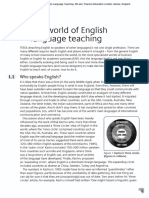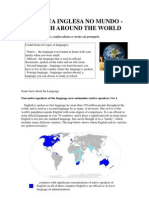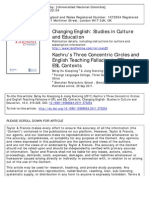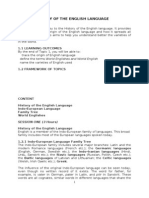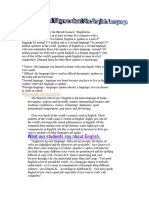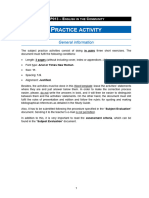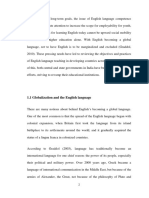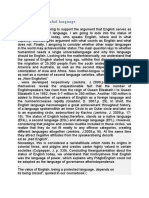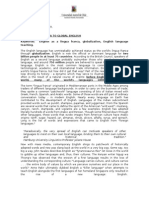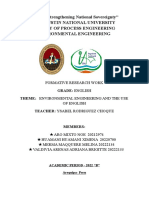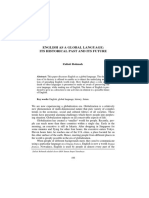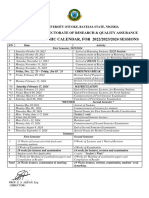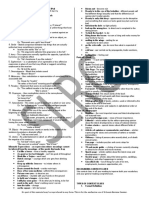Two Thousand Million?
Two Thousand Million?
Uploaded by
gkbea3103Copyright:
Available Formats
Two Thousand Million?
Two Thousand Million?
Uploaded by
gkbea3103Original Title
Copyright
Available Formats
Share this document
Did you find this document useful?
Is this content inappropriate?
Copyright:
Available Formats
Two Thousand Million?
Two Thousand Million?
Uploaded by
gkbea3103Copyright:
Available Formats
Two thousand million?
DAV I D C RY S TA L
Updates on the statistics of English
Excerpt from David Crystal, How many millions use English? (ET1, 1985)
In the reign of Queen Elizabeth – the first, that 1,400 million! Allowing a further 100 million
is, from 1558 to 1603 – the number of English for speakers as a foreign language, we here
speakers in the world is thought to have been reach a total not far off a third of the current
between 5 and 7 million. At the beginning of world population. Has this enormous jump in
the reign of the second Queen Elizabeth in the estimates, from 700 to 1400 million, any
1952, the figure had increased almost fiftyfold. justification?
In 1962, Randolph Quirk estimated in The Use Guinnemark and Kenrick do provide one clue
of English that 250 million had English as a that their total may be less dramatic than it
mother tongue, with a further 100 million using seems. Their figure, they say, ‘includes some
it as a second or foreign language. 800 million inhabitants in countries where Eng-
Fifteen years later, and we find Joshua Fish- lish is an associated official language (above all
man and his colleagues, in The Spread of Eng- India)’. Ah, India. A country whose population
lish, citing 300 million for the mother tongue increased by a quarter between 1971 and 1981.
category. A further 300 million is said to use it The 1983 population estimate for India was
as an additional language. These figures are the 698 million – a convenient figure for me to use
ones which are repeatedly quoted throughout in the present discussion, as it relates very
the statistically-conscious 1970s. They are nicely to the 700 million difference cited above.
adopted by Bailey and Görlach as recently as Indeed, it is already an underestimate, when we
1982, in their English as a World Language. But recall the world growth rate of 1.8 per cent. Or,
they are now very much out of date. In 1984, to put this another way, if this article takes you a
several sources collected by the Centre for quarter of an hour to read, you must revise your
Information on Language Teaching in London estimate of India’s population upwards by 4,000.
indicated that the figure would have to be The significance of India is obvious, when
raised by 100 million. One analysis, quite often
referred to, gives mother-tongue use as 300
million, second language use also as 300 mil- DAVID CRYSTAL is Honorary
lion, and foreign language use as 100 million. Professor of Linguistics at the
This was the total used by Quirk in his address University of Bangor, and
to the British Council’s anniversary conference works from his home in
Holyhead, North Wales,
on ‘Progress in English Studies’ in September
dividing his time between
1984. So, there we are. 700 million. authorial writing on language
But actually, there we aren’t. For in Erik Gun- and editorial management in
nemark and Donald Kenrick’s geolinguistic general reference publishing.
handbook, What Language Do They Speak?, Recent books on English
published privately in 1983, we are given a include ‘By Hook or By Crook: A Journey in Search
detailed list of English speaker totals. The home of English’ (HarperCollins, 2007) and ‘Think on my
language total is unremarkable – they cite ‘over Words: Exploring Shakespeare’s Language’ (CUP,
300 million’. It is the figure for English as an 2008). For further information, see the website
http://www.davidcrystal.com
‘official language’ which grabs the eye: over
<http://www.davidcrystal.com%22>
DOI: 10.1017/S0266078408000023
English Today 93, Vol. 24, No. 1 (March 2008). Printed in the United Kingdom © 2008 Cambridge University Press 3
http://journals.cambridge.org Downloaded: 15 Jul 2009 IP address: 131.172.180.1
you look at the table of countries where English must be an element of genuine ‘nativeness’ in
has some kind of official standing. No other the learning context. There also has to be a
population estimate in the list gets anywhere learning continuum available for people to fol-
near that country’s total. Apart from one uncer- low – at least in principle, should opportunity
tain exception which I’ll refer to shortly, what- permit.
ever is happening to English in India will lie the On this basis, we could perhaps accept Gun-
factor which decides whether our total is nearer nemark and Kenrick’s figure. But could we ever
700 or 1400 million. Or perhaps this statement go beyond it? The field of teaching English as a
should be broadened to include the whole of foreign language is ripe for serious study. What
the Indian subcontinent – that is, to include is amazing is that there are no reliable figures
Bangladesh (92.6m.), Pakistan (87.1m.), Sri available for the number of learners under this
Lanka (15.2m.), Nepal (15.8m.), and Bhutan heading – even for Europe. While preparing this
(1.2m.) – all 1983 population estimates. Braj article, I thought that at least the member states
Kachru adopts this broader perspective in his of the European Economic Community would
article on South Asian English in the Bailey and have some data available. None of them has.
Görlach collection. He points out that figures Against this must be set such quasi-facts as the
for all the functions of English in all the regions following. English radio programmes are
are not available, but he cites a widely used received by 150 million people in over 120
total of 3 per cent of the population as ‘English countries. 100 million receive programmes
knowing bilinguals’ – that is, those ‘who can use from the BBC External Service. The tip of how
English (more or less) effectively in a situation’ large an iceberg?
(p. 378). Three per cent of around 900 million And all of this is but the beginning, for we
is an easy sum: 27 million people. have to take into account the uncertain excep-
Of course, it all depends what ‘more or less’ tion which I referred to earlier, and which I
means. Kachru’s examples show that he is tak- have so far conspicuously ignored – China. In
ing a fairly conservative line here, considering 1983, around 100 million Chinese watched the
only those who have an educated awareness of BBC television series on the English language,
the language. He refers, for instance, to the Follow Me. As far as I know, the Chinese were
24.4 million students who are enrolled in Eng- not watching similar programmes in French,
lish classes, to the 23 per cent of the reading German or Arabic. China has always been
public who take an English newspaper, to the excluded from the statistical reviews, because
74 per cent of scientific journals published in of the shortage of information from inside the
India in 1971. He points out that English is the country. But these days, because of the num-
language of the legal system, a major language bers involved, special efforts should be made to
in Parliament, and a preferred language in the obtain accurate information from there. The
universities and all-India competitive examina- total number of English learners as a foreign
tions for senior administrative, engineering and language doubles when the Chinese are taken
foreign service positions. In terms of some such into account. Or quadruples, if we do not insist
notion as ‘educated awareness’ or ‘fluent com- on the passing of an English language examina-
mand’, we must accept his figure of 3 per cent, tion as a standard of entry.
at least until a better survey is carried out. But is So, if you are highly conscious of interna-
this the most relevant criterion? tional standards, or wish to keep the figures for
I am struck by the remarkable amount of world English down, you will opt for a total of
semi-fluent or ‘broken’ English which is encoun- around 700 million, in the mid-1980s. If you go
tered in the Indian sub-continent, used by peo- to the opposite extreme, and allow in any sys-
ple with a limited educational background. tematic awareness, whether in speaking, listen-
Doubtless there are people in all parts of the ing, reading or writing, you could easily per-
world who have developed a smattering of Eng- suade yourself of the reasonableness of 2
lish for trade and other purposes. After all, this billion. I am happy to settle for a billion, myself,
is how the pidgin Englishes of the world but would welcome comment as to whether I
emerged in the first place. An important con- am being too conservative or too radical. If the
straint on the criterion is that the language criticisms balance, I shall stay with this figure
must be a culturally significant element. There for a while. 䡺
4 ENGLISH TODAY 93 March 2008
http://journals.cambridge.org Downloaded: 15 Jul 2009 IP address: 131.172.180.1
READING this article again, almost a quarter that around a third of the population were
of a century on, the most noticeable change, it these days capable of carrying on a domestic
seems to me, has been in the amount and conversation in English. An India Today survey
colour of the author’s hair! That aside, I am in 1997 had reached the same conclusion
struck by my final comment: ‘I shall stay with (Kachru 2001: 411). Given that India’s popula-
this figure for a while’ – a billion. It appears I tion is now well over a billion, this meant a
stayed with it for a decade. In the first edition total of around 350 million people – more than
of my English as a Global Language (1997: 61) the combined English-speaking populations of
I raised my estimate, suggesting a middle-of- the leading first-language countries.
the-road figure of 1,350 million. In the second China also receives a special mention in the
edition (2003: 69), a ‘cautious temperament’, 1985 article. If India is the significant factor in
I said, would suggest 1,500 million. And these relation to second-language speakers (in the
days, having read the more sophisticated sense of countries where English has some sort
assessments by David Graddol and others, I of special status), then China is surely the cor-
am prepared to revise upwards again in the responding factor in relation to foreign-lan-
direction of 2 billion. In short, we have moved guage speakers (in the sense of countries
in 25 years from a fifth to a quarter to a third where the language has no official status). Esti-
of the world’s population being speakers of mates coming out of China in the late 1990s
English. suggested that the number of speakers there
India – and South Asia generally – was a pre- was around 220 million; but the motivation
occupation of the 1985 article, and that would provided by the Olympics has caused that fig-
not change if the article were being written ure to double. As with India, the estimates
today. On my last visit to India, in 2005, I cited vary depending on the level of English
bored every linguistic professional I met by the estimators have in mind. But commenta-
asking for their estimate of the number of Eng- tors I have talked to assert that China will have
lish speakers in their country today. Kachru’s nearly half its population capable of at least a
figure of 3 per cent, referred to in the 1985 basic level of conversational competence in
article, was evidently history. Although English by the end of 2008. I would not be at
answers varied greatly, depending on the lev- all surprised if this came to pass.
els of English assumed, most people thought Taken together, the estimates for second-
The author
ponders an Indian
English spelling
outside the
University of
Mumbai in 2004.
TWO THOUSAND MILLION? 5
http://journals.cambridge.org Downloaded: 15 Jul 2009 IP address: 131.172.180.1
and foreign-language competence reinforce (they are already gone in some accents, such as
the point that has been made with increasing Cockney and Irish). And in grammar, I can see
emphasis over the past ten years – that the cen- several uncountable nouns developing a count-
tre of gravity of the English language has able use – usages such as informations, for
moved from the native speaker to the non- example, which are widespread in second/for-
native speaker. For every one native speaker, eign language situations. Some people might
there are now three or four non-native speak- think these ‘un-English’, but in fact informa-
ers, a ratio that will increase as time goes by tions was in English once: an information and
(Graddol, 1999). And as the non-native group informations can be traced back to Middle Eng-
is the primary force fostering the emergence of lish, and are found in Chaucer, Shakespeare,
‘new Englishes’, there are going to be implica- Swift, and many other authors. It may only be
tions for the future character of the language. a matter of time before they are back. 䡵
Can I be specific? It is always dangerous
making predictions about languages. Who References
would have dared suggest, a thousand years Crystal, D. 2003. English as a Global Language. 2nd
ago, that Latin would today be of such little edition. Cambridge: University Press.
consequence? And the same tentativeness Graddol, D. 1999. ‘The decline of the native speaker.’
must apply to predictions about the future for- In D. Graddol & U. H. Meinhof (eds), English in a
mal character of English. But let me make a Changing World (AILA Review 13), pp. 57–68.
couple of guesses. For example, given the diffi- Kachru, B. 2001. ‘World Englishes and culture wars.’ In
T. C. Kiong, A. Pakir, B. K. Choon & R. B. Goh (eds),
culty that many foreign learners have in pro- Ariels: departures and returns. Singapore: Oxford
nouncing interdental fricatives (as in thin, University Press, pp. 392–414.
this) I would not be surprised to see them dis-
appear completely within the next fifty years
6 ENGLISH TODAY 93 March 2008
http://journals.cambridge.org Downloaded: 15 Jul 2009 IP address: 131.172.180.1
You might also like
- English in The World Revision NotesDocument14 pagesEnglish in The World Revision NotesJacint HowardNo ratings yet
- A Testament of Hope The Essential Writings of Martin Luther King Jr.Document10 pagesA Testament of Hope The Essential Writings of Martin Luther King Jr.gkbea310375% (4)
- Instructional Project 3Document5 pagesInstructional Project 3api-290533089100% (1)
- New EnglishesDocument5 pagesNew EnglishesserenaNo ratings yet
- English As A Global Language - An EssayDocument2 pagesEnglish As A Global Language - An EssayEr. Hebin Raj67% (3)
- Presentation by Prof Venansius Baryamureeba 15th June 2017Document36 pagesPresentation by Prof Venansius Baryamureeba 15th June 2017The Campus TimesNo ratings yet
- Tema 66.anglophonyDocument14 pagesTema 66.anglophonyCris BravoNo ratings yet
- Decline of The Native SpeakerDocument16 pagesDecline of The Native SpeakerengcoNo ratings yet
- Crystal - English Language TodayDocument3 pagesCrystal - English Language TodayNata KNo ratings yet
- English Language Teaching in IndiaDocument51 pagesEnglish Language Teaching in Indiaabhishek.mishraji88% (8)
- Kachru S 3 Concentric CirclesDocument11 pagesKachru S 3 Concentric CirclesOscar PardoNo ratings yet
- Future of EnglishDocument4 pagesFuture of EnglishMuhammad IbrahimNo ratings yet
- HarmerWorldDocument11 pagesHarmerWorldMaxNo ratings yet
- World Englishes - Pham Tam1Document11 pagesWorld Englishes - Pham Tam1Tammy PhamNo ratings yet
- Enem - Inglês - Apostila IDocument4 pagesEnem - Inglês - Apostila INikkolai HelNo ratings yet
- A Língua Inglesa No MundoDocument5 pagesA Língua Inglesa No Mundocarolinaribeiroo100% (1)
- Unidad 1Document76 pagesUnidad 1silviaNo ratings yet
- Kachru's Three Concentric Circles and English Teaching FallaciesDocument12 pagesKachru's Three Concentric Circles and English Teaching Fallaciesrazielka100% (2)
- Innocent 22222Document5 pagesInnocent 22222nguyenmike633No ratings yet
- Importance of EnglishDocument10 pagesImportance of EnglishyohapriyavenkatesanNo ratings yet
- Topic 1 History of The English LanguageDocument7 pagesTopic 1 History of The English LanguageMervyn Petrus Anip100% (2)
- 1 Language and CultureDocument26 pages1 Language and Culturelg00ki929No ratings yet
- Critically Discuss Whether English Should Be The World LanguageDocument10 pagesCritically Discuss Whether English Should Be The World LanguageKin Wai ChanNo ratings yet
- The World of Englishes 2Document6 pagesThe World of Englishes 2tyuaNo ratings yet
- FP013 EIC Eng PracActivDocument8 pagesFP013 EIC Eng PracActivAlbertoNo ratings yet
- Chapter 4.Document24 pagesChapter 4.thuhaphan0311No ratings yet
- Global EnglishDocument3 pagesGlobal EnglishLawa GharNo ratings yet
- NY Times Article - Across Cultures English Is The WordDocument6 pagesNY Times Article - Across Cultures English Is The WordjamesNo ratings yet
- Lingua Francasas Language Ideologies 9Document27 pagesLingua Francasas Language Ideologies 9sabbirhossen253633No ratings yet
- English As A Second LanguageDocument6 pagesEnglish As A Second LanguageczirabNo ratings yet
- Global LanguageDocument6 pagesGlobal LanguageMaaz AshrafNo ratings yet
- WWW - Referat.ro-Some Facts and Figures About The English Language - Doc016b5Document3 pagesWWW - Referat.ro-Some Facts and Figures About The English Language - Doc016b5Stela Daniela NegurăNo ratings yet
- ENGLISH As A Global LanguageDocument4 pagesENGLISH As A Global LanguageHimel IslamNo ratings yet
- Data Collection ProjectDocument8 pagesData Collection Projectapi-346138932100% (1)
- THE IMPORTANCE OF STUDYING ENGLISH TODAY Camelia Mariana GulerDocument4 pagesTHE IMPORTANCE OF STUDYING ENGLISH TODAY Camelia Mariana GulerpertaelenaNo ratings yet
- A Global LanguageDocument28 pagesA Global LanguageInsaf AliNo ratings yet
- Discuss The Future of World EnglishesDocument12 pagesDiscuss The Future of World EnglishesafzanNo ratings yet
- The Verbal Art of Borrowing FinDocument25 pagesThe Verbal Art of Borrowing FinHa Phuong AnhNo ratings yet
- FP013 CP CO Eng - v1r0 - Practice1Document12 pagesFP013 CP CO Eng - v1r0 - Practice1Rocio JimenezNo ratings yet
- A History of The English LanguageDocument3 pagesA History of The English LanguageOlivia YuliantiNo ratings yet
- English and GlobalizationDocument8 pagesEnglish and GlobalizationNehNo ratings yet
- Global English and World Englishes From An Evolutionary Perspective: A Rejoinder To Anna Kristina HultgrenDocument8 pagesGlobal English and World Englishes From An Evolutionary Perspective: A Rejoinder To Anna Kristina Hultgrentinafadilah62No ratings yet
- Wallraff-What Global LanguageDocument6 pagesWallraff-What Global LanguageabdulrahmanJRNo ratings yet
- English As A Universal LanguageDocument5 pagesEnglish As A Universal Language∂яуѕнNo ratings yet
- The Future of English Language Will Engl PDFDocument4 pagesThe Future of English Language Will Engl PDFEdson Francisco Sarmiento RodriguezNo ratings yet
- C L WrennDocument40 pagesC L Wrenntehzeeb node67% (3)
- Aen 401Document85 pagesAen 401Jackline AdikaNo ratings yet
- China English Its Distinctive Features PDFDocument6 pagesChina English Its Distinctive Features PDF何昂阳No ratings yet
- ENGLISH As A Global LanguageDocument4 pagesENGLISH As A Global LanguageNeima AbdourahmanNo ratings yet
- School Project 1Document8 pagesSchool Project 1OYEBAMIJI OLUWADARASIMI IFEOLUWANo ratings yet
- From Lingua Franca To Global English RCHDocument3 pagesFrom Lingua Franca To Global English RCHpantruca123No ratings yet
- Global English - TestDocument4 pagesGlobal English - TestMónica MeloNo ratings yet
- A Corpus of American and British English: A Case Study of SlangDocument18 pagesA Corpus of American and British English: A Case Study of SlangStefania TarauNo ratings yet
- Globish To EnglishDocument6 pagesGlobish To Englishamandeep raiNo ratings yet
- Concentric Circles of EnglishDocument15 pagesConcentric Circles of Englishrheazeenylaya16100% (1)
- English The IndustryDocument16 pagesEnglish The IndustryNhựt HàoNo ratings yet
- English As A World LanguageDocument2 pagesEnglish As A World LanguagehumayounNo ratings yet
- World EnglishesDocument2 pagesWorld EnglishesKyrby CabalquintoNo ratings yet
- English TifDocument18 pagesEnglish TifADRIANA BRIGITTE VALDIVIA ARENASNo ratings yet
- Type 4 - MCQDocument6 pagesType 4 - MCQAnh ThuNo ratings yet
- English As A Global Language - Zuliati Rohmah PDFDocument12 pagesEnglish As A Global Language - Zuliati Rohmah PDFNataliasol07No ratings yet
- Jenkins - Lingua FrancaDocument25 pagesJenkins - Lingua FrancaAnge Pange100% (1)
- The Impact of English As A Global Language On Educational Policies and Practices in The Asia-Paci C RegionDocument25 pagesThe Impact of English As A Global Language On Educational Policies and Practices in The Asia-Paci C Regiongkbea3103100% (1)
- Lingua Franca or Lingua Frankensteinia? English in European Integration and GlobalisationDocument18 pagesLingua Franca or Lingua Frankensteinia? English in European Integration and Globalisationgkbea31030% (1)
- Jackson - The Word ItselfDocument4 pagesJackson - The Word Itselfgkbea3103No ratings yet
- Crang - Locating CultureDocument8 pagesCrang - Locating Culturegkbea3103No ratings yet
- Fuotoke Revised Academic CalendarDocument1 pageFuotoke Revised Academic CalendarlaideifagumlNo ratings yet
- 11Nc Dec10Document11 pages11Nc Dec10Nhật NguyễnNo ratings yet
- RM 310 3 FLR Abalos Bldg. Gen. Aguinaldo St. Iligan CityDocument12 pagesRM 310 3 FLR Abalos Bldg. Gen. Aguinaldo St. Iligan CityDhena H Rasul SabdulaNo ratings yet
- Self University by Charles D. HayesDocument263 pagesSelf University by Charles D. HayesVitaliy Kotyakov100% (4)
- Ulat Paglalagom Sa Oral Reading Inventory (Pre-Test) Sa FilipinoDocument52 pagesUlat Paglalagom Sa Oral Reading Inventory (Pre-Test) Sa FilipinoEdzmarie LaranjoNo ratings yet
- IPSDR-Microsoft IT Academy: Kumaon University NainitalDocument18 pagesIPSDR-Microsoft IT Academy: Kumaon University NainitalswalayNo ratings yet
- Reflection On Work ImmersionDocument2 pagesReflection On Work ImmersionJeve GalveNo ratings yet
- ADHD and Self EfficacyDocument20 pagesADHD and Self Efficacygeorgianaberariu6758No ratings yet
- Research On Youth Employment and EmployabilityDocument239 pagesResearch On Youth Employment and EmployabilityManoa Nagatalevu TupouNo ratings yet
- 6-27-11 Cubberley Site OverviewDocument17 pages6-27-11 Cubberley Site OverviewCitizen360No ratings yet
- Prescription Drug Abuse Crisis in NYS - Comprehensive ApproachDocument26 pagesPrescription Drug Abuse Crisis in NYS - Comprehensive ApproachNew York SenateNo ratings yet
- Resume-Ayla TeachingDocument3 pagesResume-Ayla Teachingapi-276780872No ratings yet
- Report FormatDocument6 pagesReport FormatMohit TiwariNo ratings yet
- "School Is A Scam" Mantra A Product of Nigerian Education DecadenceDocument13 pages"School Is A Scam" Mantra A Product of Nigerian Education DecadencedanielhalleluyahelijahNo ratings yet
- Subject Enrichment Activity - Summer Vacations 2020 Subject - EnglishDocument2 pagesSubject Enrichment Activity - Summer Vacations 2020 Subject - EnglishFinly MathewNo ratings yet
- M EdProspectusDocument15 pagesM EdProspectusPrakash ThulasidasNo ratings yet
- Publishable Paper 1Document22 pagesPublishable Paper 1Khen Lloyd Montes MansuetoNo ratings yet
- DLP For DemoDocument7 pagesDLP For DemoMary Ann RascoNo ratings yet
- Philosophy of EducationDocument7 pagesPhilosophy of Educationapi-696797501No ratings yet
- Introduction To Communication ResearchDocument12 pagesIntroduction To Communication ResearchNadine GabaoNo ratings yet
- InstructIonal Project 3 Research PaperDocument6 pagesInstructIonal Project 3 Research Paperapi-459665908No ratings yet
- NU International NCLEX PASS Endorsement CESDocument9 pagesNU International NCLEX PASS Endorsement CESRalph Dennis VicenteNo ratings yet
- Domain 3 and LP For Subtraction With Regrouping of 100s Column MeshDocument9 pagesDomain 3 and LP For Subtraction With Regrouping of 100s Column Meshapi-398643907No ratings yet
- 03 Mech Ug Full 7copiesDocument308 pages03 Mech Ug Full 7copiesEngineerNo ratings yet
- Professional Education Reviewer by LET Reviewer UniversityDocument12 pagesProfessional Education Reviewer by LET Reviewer UniversityRonald Carnice0% (1)
- Study Plan Department of Physics (KAU)Document18 pagesStudy Plan Department of Physics (KAU)Alt4irNo ratings yet
- A Short Biography of Heinrich Witt : Christa WetzelDocument79 pagesA Short Biography of Heinrich Witt : Christa WetzelМаша КрахмалёваNo ratings yet
- Art 133-Unit 1 PaperDocument3 pagesArt 133-Unit 1 Paperapi-370929280No ratings yet












